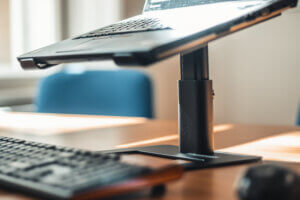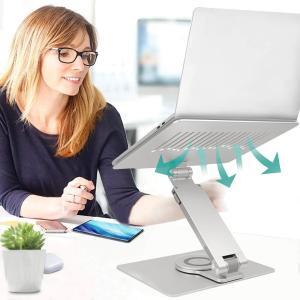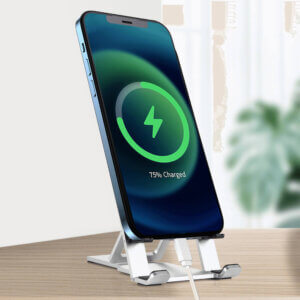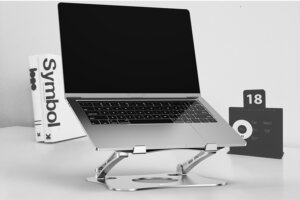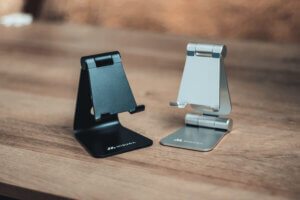Many of us spend most of our working day behind a computer monitor . As recently as fifty years ago, our ancestors were turning at machines in production. Two hundred years ago, most of our ancestors worked in the fields. Physical labor, constant focusing of the eyes near and far, no blue light component after dark – that’s what our bodies have been used to for millennia. Evolutionarily, the human body is not built for sedentary work with no movement, or constantly watching a nearby screen emitting blue light. Moreover, if we sit for long periods of time at work in an inappropriate way, we are at risk of cervical spine problems, shoulder problems, stiff necks, or back pain. Therefore, it is important to position the monitor to minimize sensitive areas of the body and avoid long-term negative health consequences in the future.
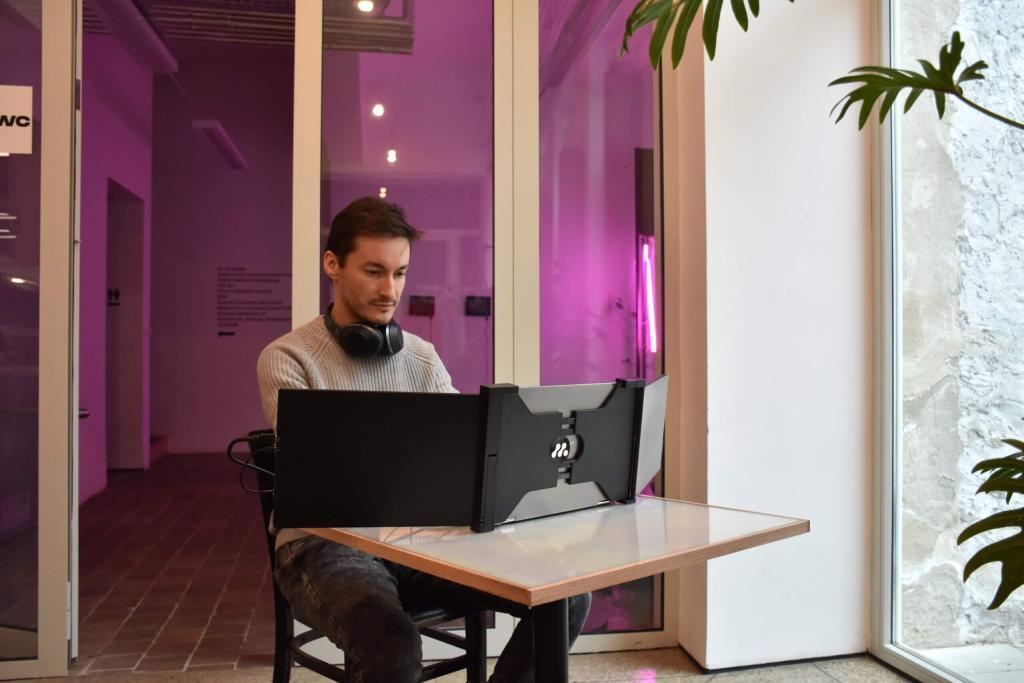

Adapt your working environment
Your eyes should be approximately level with the top of the monitor. This will keep your head in a straight position and prevent uncomfortable neck pain. Another interesting option is to place the monitor on a wall mount or desk. What if you have a laptop and you have to look at it from the top down? You can get a laptop stand to place your laptop on, raising it to your desired eye level. Just add an external keyboard to it so that your hands stay resting on the table top. If you work on your computer late into the night, you should also think more about your eyes. You can start by dimming the brightness. Ideally, we recommend looking for glasses that eliminate the blue component of light. These have the advantage that they will also work on other light sources in your surroundings. If you don’t have glasses, current operating systems have a night mode in the settings
Put MISURA monitors on your laptop
In order to enjoy the comfort of multiple monitors on the go, many companies have started to produce portable monitors. You take the monitor out of your backpack or bag, flip out the stand, set it next to your laptop and you’re ready to work. Do you have the monitors close enough together? Are your eyes level? And what if you want to have your laptop on your lap, or there’s not enough room on your desk? That’s why MISURA triscreen monitors were created. You attach the monitors to the lid of your laptop. You have three screens in one plane. No need for extra storage space on the desk. The side monitors can be rotated together with the laptop or independently of it.
Put MISURA monitors on your laptop
In order to enjoy the comfort of multiple monitors on the go, many companies have started to produce portable monitors. You take the monitor out of your backpack or bag, flip out the stand, set it next to your laptop and you’re ready to work. Do you have the monitors close enough together? Are your eyes level? And what if you want to have your laptop on your lap, or there’s not enough room on your desk? That’s why MISURA triscreen monitors were created. You attach the monitors to the lid of your laptop. You have three screens in one plane. No need for extra storage space on the desk. The side monitors can be rotated together with the laptop or independently of it.
Position the monitor at the correct height
Attention must also be paid to the positioning of the monitor. It should preferably be placed directly in front of you, not to the side so that you have to turn or tilt your head and strain your neck muscles. Depending on the size of the screen, the distance between you and the monitor should be between 50 and 80 centimetres – about the length of your arm
- The monitor should ideally be positioned centrally on a flat surface in front of you. If it is not in the centre, you will have to turn your neck frequently, which can cause shoulder or neck pain.
- The top edge of the monitor must be at eye level. This avoids the following situations:
- shoulder and neck pain from moving your head backwards if the monitor is placed too high.
- neck pain from moving your head downwards if the monitor is placed too low.
Adjust the height of the monitor so that the top of the screen is at or slightly below eye level. When looking at the centre of the screen, your eyes should be slightly downwards. Position (tilt) the screen to minimize glare. Maintain the distance between your eyes scanning the screen and the screen by tilting the monitor back 10° to 20°
If you are working on a laptop, use a height-adjustable laptop stand to adjust the height of the monitor.
- The monitor should ideally be positioned centrally on a flat surface in front of you. If it is not in the centre, you will have to turn your neck frequently, which can cause shoulder or neck pain.
- The top edge of the monitor must be at eye level. This avoids the following situations:
- shoulder and neck pain from moving your head backwards if the monitor is placed too high.
- neck pain from moving your head downwards if the monitor is placed too low.
Adjust the height of the monitor so that the top of the screen is at or slightly below eye level. When looking at the centre of the screen, your eyes should be slightly downwards. Position (tilt) the screen to minimize glare. Maintain the distance between your eyes scanning the screen and the screen by tilting the monitor back 10° to 20°
If you are working on a laptop, use a height-adjustable laptop stand to adjust the height of the monitor.
Adjust the monitor angle – right angle
Correct monitor adjustment should ensure that you do not tilt your head forward. Still, keep this annoyance in mind and try to get rid of it. It is bad for your cervical spine and can cause neck and headaches. Otherwise, the basic rule of healthy sitting at the computer is simple: all right angles on your arms and legs.
So keep an eye on:
- Feet flat on the floor and right angles at the knees.
- Right angle between forearms and arms, elbows should be level with hips.
- Don’t lift or droop your shoulders too much and as they say – don’t slouch. A straight back will help keep your hips supported. If your chair doesn’t have one, put a rolled-up sweater or towel between the backrest and your hips.
- Place the monitor in a horizontal position on the stand.
- Adjust the angle of the screen. The screen angle can be adjusted from -5° to 15° in front or back for an ideal experience.
The keyboard is also important
When choosing a keyboard, look for one that you can rest the palm of your hand comfortably, for example, because the keyboard can be tilted. The height of the keyboard should match the height of your elbows and possibly. The correct arrangement of mouse and keyboard can effectively prevent carpal tunnel syndrome.
Avoid health risks
Frequently repeating the same movements strains the arms and hands. The tendons and tendon sheaths in the elbows and wrists are particularly affected. The unnatural and long-lasting wrist position that is typical of working with mice results in tingling, hypersensitivity to touch and can even lead to chronic inflammation. Abroad, these disorders are referred to collectively as repetitive strain injuries (RSI; in sport, ‘tennis elbow ‘ is used for a similar set of injuries and is all too familiar to violin players).
These include injuries to the muscles of the hands, wrists, arms and shoulders. A major problem is the asymmetrical loading of certain muscle groups. For example, if you are on the phone a lot and hold the receiver with your shoulder while typing on the computer, the muscles on the opposite side of your back shorten. Prevention starts with the right furniture and workstation layout, continues with the right seating, and culminates in choosing the right monitor.
Put your desk and monitor in the right place
When arranging furniture, particular care should be taken to position the desk in relation to the window. The desk on which the computer monitor is placed should not be parallel to the window. If it is placed against the window, the large light area is distracting and detracts from the monitor. It is also less contrasty, which only causes further eye strain. If, on the other hand, you were sitting with your back to the window, the light and glare would make the monitor almost unreadable.
Theheight of the desk should be between 60 and 70 centimetres, depending on the height of the worker. The top edge of the monitor should be about eye level. Experts recommend that the monitor should be as far away from the employee as possible, at least 30 centimetres and ideally 100 centimetres.
You can also reduce glare on the monitor by tilting the monitor slightly forward. Another option is to reduce the brightness and increase the contrast or use a screen filter.
Save your eyesight with the monitor
A healthy person perceives more than four-fifths of the world through sight, with the rest going to the other senses. When working on a computer for long periods of time, vision is the most stressed part of the body. This is due to at least two factors. Focusing the eye at one distance and poorly adjusted imaging equipment.
Of course, it is not natural for the eye to remain focused at a certain distance for a long time when looking at a monitor. This organ is designed to monitor the environment where different objects are at different distances. Fixing the eye at a constant distance can cause visual defects after a long period of time. Whenever possible, turn your eyes away from the monitor and view the surroundings and distant objects. Taking small breaks where you can not only stretch your body but also do some eye exercises is also not a bad thing.
A healthy person perceives more than four-fifths of the world through sight, with the rest going to the other senses. When working on a computer for long periods of time, vision is the most stressed part of the body. This is due to at least two factors. Focusing the eye at one distance and poorly adjusted imaging equipment.
Of course, it is not natural for the eye to remain focused at a certain distance for a long time when looking at a monitor. This organ is designed to monitor the environment where different objects are at different distances. Fixing the eye at a constant distance can cause visual defects after a long period of time. Whenever possible, turn your eyes away from the monitor and view the surroundings and distant objects. Taking small breaks where you can not only stretch your body but also do some eye exercises is also not a bad thing.
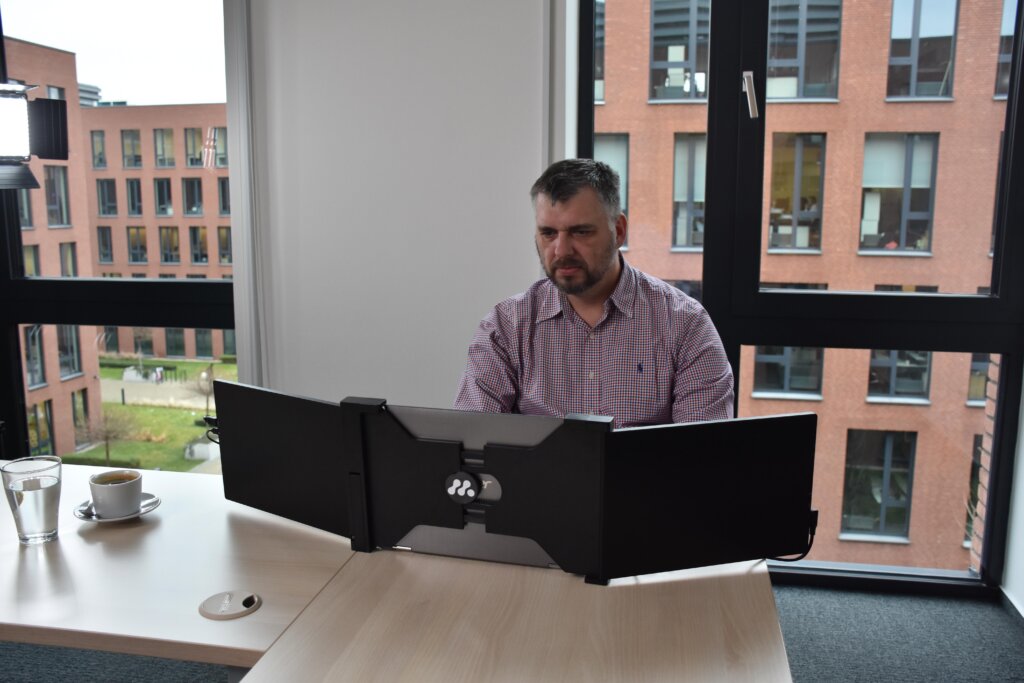

Sit properly on the chair
A good quality chair is the basis for a proper and healthy sitting.“When choosing a new chair, it is most important that it is swivellable and has an adjustable seat height and, if necessary, spinal support,” Dr. Soukupová advises those who can choose their own chair. But if you don’t have a choice, even a simple chair can ensure healthy sitting.
Proper seating can be summed up in a simple motto: all right angles. The feet are placed on the floor or on a mat. There is a right angle between the calves and the thighs, as well as between the thighs and the back. There should also be a right angle between the forearm and the arm. The palms should be at the same level as the keyboard. It is recommended that they are supported, e.g. by a gel pad, so that they are higher than the keyboard.
Sitting for long periods of time puts uneven pressure on the intervertebral discs, causing pain. To prevent spinal problems, it is recommended to place a folded towel or sweater under your back (roughly in the lumbar region). Supporting your back in the sacral area makes it easier to sit properly.
A good quality chair is the basis for a proper and healthy sitting.“When choosing a new chair, it is most important that it is swivellable and has an adjustable seat height and, if necessary, spinal support,” Dr. Soukupová advises those who can choose their own chair. But if you don’t have a choice, even a simple chair can ensure healthy sitting.
Proper seating can be summed up in a simple motto: all right angles. The feet are placed on the floor or on a mat. There is a right angle between the calves and the thighs, as well as between the thighs and the back. There should also be a right angle between the forearm and the arm. The palms should be at the same level as the keyboard. It is recommended that they are supported, e.g. by a gel pad, so that they are higher than the keyboard.
Sitting for long periods of time puts uneven pressure on the intervertebral discs, causing pain. To prevent spinal problems, it is recommended to place a folded towel or sweater under your back (roughly in the lumbar region). Supporting your back in the sacral area makes it easier to sit properly.
Make use of bolsters, balloons and pads
For those who are really serious about healthy sitting or already suffer from a disorder, there are sophisticated aids.
If varicose veins run in your family, you should focus on preventing them. In addition to frequent breaks from work and exercise, this can include a movable massage pad under the feet
, which promotes the movement of the feet, better blood circulation and thus prevents their swelling.
Inflatable balloons (either large ones that replace a chair or small ones that are placed on the seat of a chair) are often recommended as an alternative to sitting. Balancing on them strengthens the muscular corset and makes it impossible to sit on them except upright. “Sitting balloons, like the once-fashionable kneeling balloons, are a welcome change, but I don’t recommend them for all-day sitting,” warns Dr. Soukup.
Aback support has the same function as a folded towel under the sacral area of the spine, but it allows for precise adjustment of the support and does not deform.
Opinions on armrests for work chairs vary. On the one hand, they help to hold the arms in the correct position, but if they are made of hard material, they can be harmful by putting pressure on the elbow and forearm.
Keep moving
Sitting in the right chair is just one pillar of a healthy back. The other is taking regular breaks, preferably every 20 minutes, during which you stretch (we’ll bring you exercises to stretch your spine in future parts of this series).
An important factor is time spent at the computer. Once it exceeds about 6 hours, even a well-organized space and good seating will not prevent fatigue. However, in case you take breaks at work, you get tired after a longer period of time. It is recommended to take breaks every half an hour. Just get up, walk around and stretch a bit, look out the window.
To improve the ergonomics of the workplace, so-called dynamic seating can be used. When sitting, make sure that you move as much as possible, e.g. stretch your legs or swing your chair from time to time. Women in particular should take care not to sit cross-legged, which encourages the development of varicose veins. When working at a computer for long periods of time, it is also advisable to elevate the position of the legs, for example, by using foot pads or lifting them onto a chair or table.
An important factor is time spent at the computer. Once it exceeds about 6 hours, even a well-organized space and good seating will not prevent fatigue. However, in case you take breaks at work, you get tired after a longer period of time. It is recommended to take breaks every half an hour. Just get up, walk around and stretch a bit, look out the window.
To improve the ergonomics of the workplace, so-called dynamic seating can be used. When sitting, make sure that you move as much as possible, e.g. stretch your legs or swing your chair from time to time. Women in particular should take care not to sit cross-legged, which encourages the development of varicose veins. When working at a computer for long periods of time, it is also advisable to elevate the position of the legs, for example, by using foot pads or lifting them onto a chair or table.

